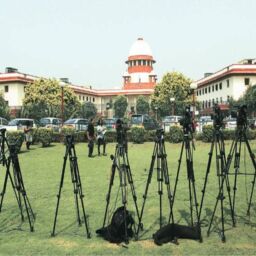INTRODUCTION
After 75 years of independence, India has taken great strides in economic arena but still gripped in one of the most inhuman practices, manual scavenging. Defined as ‘the removal of human excrement from public streets and dry latrines, cleaning septic tanks, gutters and sewers’ manual scavenging has taken a toll of lives since time immemorial. Most often it is done by those who belong to economically weak and socially backward background. This worst form of untouchability is most prevalent in Andhra Pradesh, Assam, Jammu and Kashmir and Maharashtra. They account for 72% of the cases reported as per Housing Listing and Housing Census, 2011.
WOMEN MANUAL SCAVENGERS
Socio-Economic factors have made women 20% more susceptible to manual scavenging. They are exposed to this practice as young girls and any defiance from their side would lead to ostracization from the society. On account of discrimination and oppression they face, they move out to an alternate livelihood.
A Survey conducted in 2015 exposes the hard reality of women workers where contractors claiming handkerchief to be an adequate protection from toxic gases. They often face hair loss, nausea, palpitations and frequent infections. Even during pregnancy, they are made to carry heavy baskets of human excreta which cause irreparable damage to their physical health and the baby. This is an egregious violation of Article 15, 17 and 21 of the Indian Constitution.
“The founding faith upon which the Constitution is based on the belief that it is in the dignity of each individual that the pursuit of happiness is founded. Human dignity postulates an equality between persons” – Indian Young Lawyer Association and Others v. State of Kerala[1]. Rajagopala Sinha in Kharak Singh v. The State of Uttar Pradesh and Others[2] mentioned that life is not ‘mere animal existence’. In Bandhua Mukti Morcha v Union of India and Ors.[3] Justice Bagawati has expanded ‘right to life’ to include ‘right to livelihood’. Confirming to the provisions of Workmen’s Compensation Act, 1923 and the Employees’ Provident Funds and Miscellaneous Provisions Act, 1952, working in an unorganised sector deprives them of pensions and other benefits. They are divested of daily wage for 6 weeks post-delivery which is guaranteed under Maternity Benefit Act, 1961.
LEGISLATION IN SEARCH OF DIGNITY
Various efforts have been garnered to do away with this callous practice in India. Employment of Manual Scavengers and Construction of Dry Latrines (Prohibition) Act, 1993 prohibited the employment of manual scavengers and the construction and continuance of dry latrines. However, public health and sanitation comes under Article 246 entry 6 of State List in Indian Constitution. This makes it difficult for the Union government to regulate and enforce the legislation. Hence a new Act was enacted in 2013 under Entry 97 of Union List. National Commission for Safai Karamcharis was also constituted in 1994 to look into the workers issues.
Prohibition of Employment as Manual Scavengers Act, 2013 has been a cornerstone in upgrading the life of scavengers by emphasising on rehabilitation. It provided for cash assistance to a member of the household, voluntary skill development training, capital subsidy and concessional loans, and scholarships for children. Central and state level committees were sanctioned to keep a tab on its implementation. Self-Employment Scheme for Rehabilitation of Manual Scavengers (hereby SRMS) has been instituted by the Department of Social Justice and Empowerment to ensure rehabilitation of former manual scavengers. Moreover, the statute has widened the definition of manual scavenging from physically cleaning human excreta to ‘manual collection, source separation, storage, transportation, transfer, processing, treatment and disposal of solid waste and the proper handling, treatment and disposal of liquid waste / wastewater or sewage’.
The act contains provisions of penalties if any person or body employs anyone directly or indirectly for hazardous cleaning of sewage or septic tanks. Section 5 of the Act mandates the construction of unsanitary latrines. However, implementation of these laws has been a failure. The state representatives fail to enact provisions set by central government, thus bolstering this barbaric practice. This is visible from the fact that not even one FIR has been filed in 2014 as per the reports of 57th Standing Committee of Social Justice and Empowerment, 2017-2018. For over 27 years up to 2020, 1013 people died while serving as manual scavengers as stated by bureaucrat in the ministry of social justice and empowerment.
Though the linchpin of 2013 Act was rehabilitation, effort was taken in ensuring it, when Supreme Court interceded the matter. In Safai Karmachari v. Union of India[4], Supreme Court has remarked manual scavenging as a clear violation of Article 17 of Indian Constitution. In 2019, the apex court observed that
“In no country, people are sent to gas chambers to die. Every month four to five people lose their lives in manual scavenging”.
CONCLUSION & SOLUTIONS
SRMS need to amend to include plans and schemes for women manual scavengers. The proclamation by various panchayats asserting their area to be ‘manual scavenging free’, should be officially announced to be void and instruction should be set forth for identification of fresh scavengers. Data should be collected in a better way since it would help in improved rehabilitation measures. Camps regarding health, education and social welfare should be provided to women manual scavengers and their family should be enlisted in schemes providing benefits to them.
Sewage cleaning should be mechanised. A shift from ‘man hole’ to ‘machine hole’ is necessary. Women manual scavengers who have been rehabilitated, community leaders and representatives from the government should campaign against manual scavenging and enlighten the society with the laws and the rights available to them.
Grants for rehabilitation under SRMS should be increased in order to set up feasible enterprises. Women manual scavengers who work as manual scavengers should be enrolled in National Urban and Rural Livelihood Missions. Besides, financial incentives should be given to families with dry latrines to convert it into sanitary latrines. Employers working in Water, Sanitation and Hygiene (WASH) should work in unanimity to enforce the rights of women manual scavengers and make their lives better.
Author(s) Name: Nimmy Maria Babu (Dr. Ram Manohar Lohiya National Law University, Lucknow)
References:
[1] (2019) 11 SCC 1.
[2] 1964 SCR (1) 332.
[3] 1984 SCR (2) 67.
[4] (2011) 15 SCC 611.
















